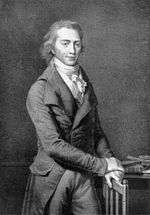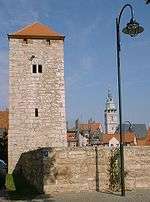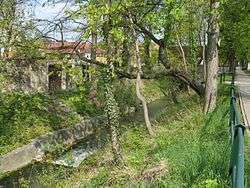Bad Langensalza
| Bad Langensalza | ||
|---|---|---|
|
The historical centre of Bad Langensalza | ||
| ||
 Bad Langensalza Location of Bad Langensalza within Unstrut-Hainich-Kreis district  | ||
| Coordinates: 51°6′29″N 10°38′48″E / 51.10806°N 10.64667°ECoordinates: 51°6′29″N 10°38′48″E / 51.10806°N 10.64667°E | ||
| Country | Germany | |
| State | Thuringia | |
| District | Unstrut-Hainich-Kreis | |
| Government | ||
| • Mayor | Matthias Reinz (Ind.) | |
| Area | ||
| • Total | 123.11 km2 (47.53 sq mi) | |
| Elevation | 202 m (663 ft) | |
| Population (2017-12-31)[1] | ||
| • Total | 17,305 | |
| • Density | 140/km2 (360/sq mi) | |
| Time zone | CET/CEST (UTC+1/+2) | |
| Postal codes | 99941–99947 | |
| Dialling codes | 03603 | |
| Vehicle registration | UH | |
| Website |
www | |
Bad Langensalza (until 1956: Langensalza) is a spa town of 17,500 inhabitants in the district of Unstrut-Hainich, Thuringia, Germany.
History

It was first mentioned in historical records ca. 932, as a village named "Salzaha". The town's name was changed to Langensalza ca. 1578, and "Bad" or "Bath" was added to the name in 1956.
In 1075, Langensalza was the site of a battle, in which Emperor Henry IV won over the rebelling Saxons and Thuringians.
The town was plundered and damaged by fires during the Thirty Years' War (c. 1632). Fires again destroyed large parts of the town in 1711, including complete destruction of the town hall, which was rebuilt between 1742-1752.
War again affected the town during 1756-1763, during the Seven Years' War; it was the scene of a battle in February 1761. In 1815 Langensalza became part of the Prussian Province of Saxony. In 1866 it was again the site of a battle between Prussia and Hanover during the Austro-Prussian War.[2]
American troops occupied the town in 1945.
Local council
The elections in May 2014 showed the following results:[3]
| Party / List | Vote share | Seats |
| CDU | 29,4 % | 7 |
| The Left | 20,2 % | 5 |
| SPD | 14,7 % | 3 |
| FDP | 20,4 % | 5 |
| WIR (=We) | 15,3 % | 4 |
Main sights
Langensalza is something of a tourist spot, with picturesque ruins of a medieval castle, and sulphur baths nearby.
The sulphur baths were discovered in 1811, and opened to the public as a curative bath in 1812. A new version of the public sulphur bath was opened in 1928. Salt and mineral water springs were discovered in 1996, which prompted the opening of many new curative facilities.
Bad Langensalza contains a botanical garden, the Botanischer Garten in Bad Langensalza which opened in 2002, and also borders National Park Hanich, founded in 1999.
International relations
Bad Langensalza is twinned with:
Notable people

- Hermann von Salza (around 1170-1239), 4th Master of the Teutonic Order
- Georg Neumark (1621-1681), composer and poet
- Johann Christian Wiegleb (1732-1800), naturalist and pharmacist
- Christoph Wilhelm Hufeland (1762-1836), physician, founder of macrobiotics
- Hermann Bonitz (1814-1888), scholar and educator
- Ulrich Kleemann (1892-1963), general of tank troops in Second World War
- Rudolf Batz (1903-1961), Sturmbannführer, leader of Einsatzkommando 2, responsible for the mass murder of Jews in the Baltics
- Dieter Fromm (born 1948), middle-distance runner
- Uwe Barth (born 1964), politician (FDP)
- Radost Bokel (born 1975), actress
- Claudia Schramm (born 1975), bobsledder
- Enrico Kühn (born 1977), bobsledder
- Marco Engelhardt (born 1980), football player
- Silvio Heinevetter (born 1984), handball goalkeeper
- Matthias Rahn (born 1990), footballer
References
- ↑ "Bevölkerung der Gemeinden, Gemeinschaftsfreie Gemeinde, erfüllende/beauftragende Gemeinden, Verwaltungsgemeinschaft/Mitgliedsgemeinden in Thüringen". Thüringer Landesamt für Statistik (in German). September 2018.
- ↑

- ↑ Bekanntmachung des Thüringer Landesamt für Statistik, abgerufen am 24. März 2016
External links

- Official website
Gallery
- Market Church
- Town Hall
- Friederikenschlösschen
- Klagentor (one of the medievial city gates)
 Oubliette
Oubliette
